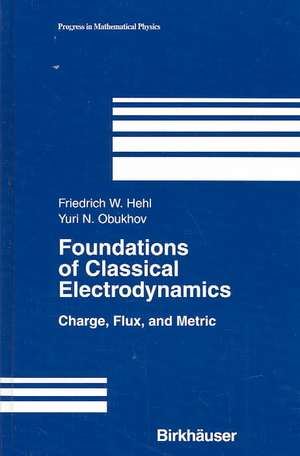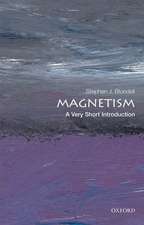Foundations of Classical Electrodynamics: Charge, Flux, and Metric: Progress in Mathematical Physics, cartea 33
Autor Friedrich W Hehl, Yuri N. Obukhoven Limba Engleză Hardback – 7 aug 2003
| Toate formatele și edițiile | Preț | Express |
|---|---|---|
| Paperback (1) | 462.42 lei 6-8 săpt. | |
| Birkhäuser Boston – 23 oct 2012 | 462.42 lei 6-8 săpt. | |
| Hardback (1) | 595.86 lei 6-8 săpt. | |
| Birkhäuser Boston – 7 aug 2003 | 595.86 lei 6-8 săpt. |
Din seria Progress in Mathematical Physics
-
 Preț: 377.18 lei
Preț: 377.18 lei -
 Preț: 398.92 lei
Preț: 398.92 lei -
 Preț: 395.25 lei
Preț: 395.25 lei -
 Preț: 391.02 lei
Preț: 391.02 lei -
 Preț: 396.62 lei
Preț: 396.62 lei -
 Preț: 396.62 lei
Preț: 396.62 lei - 20%
 Preț: 481.48 lei
Preț: 481.48 lei -
 Preț: 399.29 lei
Preț: 399.29 lei -
 Preț: 391.02 lei
Preț: 391.02 lei -
 Preț: 381.98 lei
Preț: 381.98 lei - 18%
 Preț: 1239.85 lei
Preț: 1239.85 lei - 18%
 Preț: 1118.93 lei
Preț: 1118.93 lei - 15%
 Preț: 649.87 lei
Preț: 649.87 lei - 15%
 Preț: 575.10 lei
Preț: 575.10 lei - 18%
 Preț: 786.18 lei
Preț: 786.18 lei - 15%
 Preț: 656.10 lei
Preț: 656.10 lei -
 Preț: 395.25 lei
Preț: 395.25 lei -
 Preț: 382.18 lei
Preț: 382.18 lei - 15%
 Preț: 648.56 lei
Preț: 648.56 lei - 15%
 Preț: 649.06 lei
Preț: 649.06 lei - 15%
 Preț: 645.60 lei
Preț: 645.60 lei -
 Preț: 392.21 lei
Preț: 392.21 lei -
 Preț: 409.13 lei
Preț: 409.13 lei - 15%
 Preț: 690.62 lei
Preț: 690.62 lei - 15%
 Preț: 704.69 lei
Preț: 704.69 lei - 15%
 Preț: 654.43 lei
Preț: 654.43 lei - 15%
 Preț: 646.30 lei
Preț: 646.30 lei -
 Preț: 398.35 lei
Preț: 398.35 lei -
 Preț: 402.76 lei
Preț: 402.76 lei - 15%
 Preț: 588.50 lei
Preț: 588.50 lei -
 Preț: 388.72 lei
Preț: 388.72 lei - 18%
 Preț: 781.62 lei
Preț: 781.62 lei -
 Preț: 408.16 lei
Preț: 408.16 lei -
 Preț: 391.79 lei
Preț: 391.79 lei
Preț: 595.86 lei
Preț vechi: 701.01 lei
-15% Nou
Puncte Express: 894
Preț estimativ în valută:
114.01€ • 119.36$ • 94.34£
114.01€ • 119.36$ • 94.34£
Carte tipărită la comandă
Livrare economică 05-19 aprilie
Preluare comenzi: 021 569.72.76
Specificații
ISBN-13: 9780817642228
ISBN-10: 0817642226
Pagini: 113
Ilustrații: XV, 113 p.
Dimensiuni: 155 x 235 x 24 mm
Greutate: 0.75 kg
Ediția:2003
Editura: Birkhäuser Boston
Colecția Birkhäuser
Seria Progress in Mathematical Physics
Locul publicării:Boston, MA, United States
ISBN-10: 0817642226
Pagini: 113
Ilustrații: XV, 113 p.
Dimensiuni: 155 x 235 x 24 mm
Greutate: 0.75 kg
Ediția:2003
Editura: Birkhäuser Boston
Colecția Birkhäuser
Seria Progress in Mathematical Physics
Locul publicării:Boston, MA, United States
Public țintă
ResearchCuprins
Preface y.- Five plus one axioms.- Topological approach.- Electromagnetic spacetime relation as fifth axiom.- Electrodynamics in matter and the sixth axiom.- List of axioms.- A reminder: Electrodynamics in 3-dimensional Euclidean vector calculus.- On the literature.- References.- A Mathematics: Some Exterior Calculus.- Why exterior differential forms?.- A.1 Algebra.- A.2 Exterior calculus.- A.3 Integration on a manifold.- References.- B Axioms of Classical Electrodynamics.- B.1 Electric charge conservation.- B.2 Lorentz force density.- B.3 Magnetic flux conservation.- B.4 Basic classical electrodynamics summarized, example.- B.5 Electromagnetic energy-momentum current and action.- References.- C More Mathematics.- C.1 Linear connection.- C.2 Metric.- References.- D The Maxwell—Lorentz Spacetime Relation.- D.1 A linear relation between H and F.- D.2 Propagation of electromagnetic waves: Quartic wave surface.- D.3 First constraint: Electric/magnetic reciprocity.- D.4 Second constraint: Vanishing skewon field. Emergence of the light cone.- D.5 Extracting the metric by an alternative method.- D.6 Fifth axiom: Maxwell-Lorentz spacetime relation.- References.- E Electrodynamics in Vacuum and in Matter.- E.1 Standard Maxwell-Lorentz theory in vacuum.- E.2 Electromagnetic spacetime relations beyond locality and linearity.- E.3 Electrodynamics in matter, constitutive law.- E.4 Electrodynamics of moving continua.- References.- ®Outlook.- How does gravity affect electrodynamics?.- Reissner—Nordström solution.- Rotating source: Kerr—Newman solution.- Electrodynamics outside black holes and neutron stars.- Force-free electrodynamics.- Remarks on topology and electrodynamics.- Superconductivity: Remarks on Ginzburg—Landau theory.- Classical (first quantized) Dirac field.-On the quantum Hall effect and the composite fermion.- On quantum electrodynamics.- On electroweak unification.- References.- Author Index.
Recenzii
"[The authors] …have stressed the phenomena underlying the axioms chosen and the operational interpretation of the quantities introduced. In this, they have clearly succeeded."
—Mathematical Reviews
"Throughout this book, the rationalized MKS system of units is used, making analysis more intelligible, and there are many diagrams which are of great help in understanding the text. Each part of the book is followed by a copious list of references.... Also, in appropriate places there are indications how computer algebra (REDUCE/EXCALC) can be used.... The printing and appearance of the book are excellent.... It can be warmly recommended."
—Zentralblatt Math
—Mathematical Reviews
"Throughout this book, the rationalized MKS system of units is used, making analysis more intelligible, and there are many diagrams which are of great help in understanding the text. Each part of the book is followed by a copious list of references.... Also, in appropriate places there are indications how computer algebra (REDUCE/EXCALC) can be used.... The printing and appearance of the book are excellent.... It can be warmly recommended."
—Zentralblatt Math
Textul de pe ultima copertă
This book presents a fresh, original exposition of the foundations of classical electrodynamics in the tradition of the so-called metric-free approach. The fundamental structure of classical electrodynamics is described in the form of six axioms: (1) electric charge conservation, (2) existence of the Lorentz force, (3) magnetic flux conservation, (4) localization of electromagnetic energy-momentum, (5) existence of an electromagnetic spacetime relation, and (6) splitting of the electric current into material and external pieces.
The first four axioms require an arbitrary 4-dimensional differentiable manifold. The fifth axiom characterizes spacetime as the environment in which the electromagnetic field propagates — a research topic of considerable interest — and in which the metric tensor of spacetime makes its appearance, thus coupling electromagnetism and gravitation. Repeated emphasis is placed on interweaving the mathematical definitions of physical notions and the actual physical measurement procedures.
The tool for formulating the theory is the calculus of exterior differential forms, which is explained in sufficient detail, along with the corresponding computer algebra programs. Prerequisites for the reader include a knowledge of elementary electrodynamics (with Maxwell's equations), linear algebra and elementary vector analysis; some knowledge of differential geometry would help. Foundations of Classical Electrodynamics unfolds systematically at a level suitable for graduate students and researchers in mathematics, physics, and electrical engineering.
The first four axioms require an arbitrary 4-dimensional differentiable manifold. The fifth axiom characterizes spacetime as the environment in which the electromagnetic field propagates — a research topic of considerable interest — and in which the metric tensor of spacetime makes its appearance, thus coupling electromagnetism and gravitation. Repeated emphasis is placed on interweaving the mathematical definitions of physical notions and the actual physical measurement procedures.
The tool for formulating the theory is the calculus of exterior differential forms, which is explained in sufficient detail, along with the corresponding computer algebra programs. Prerequisites for the reader include a knowledge of elementary electrodynamics (with Maxwell's equations), linear algebra and elementary vector analysis; some knowledge of differential geometry would help. Foundations of Classical Electrodynamics unfolds systematically at a level suitable for graduate students and researchers in mathematics, physics, and electrical engineering.













